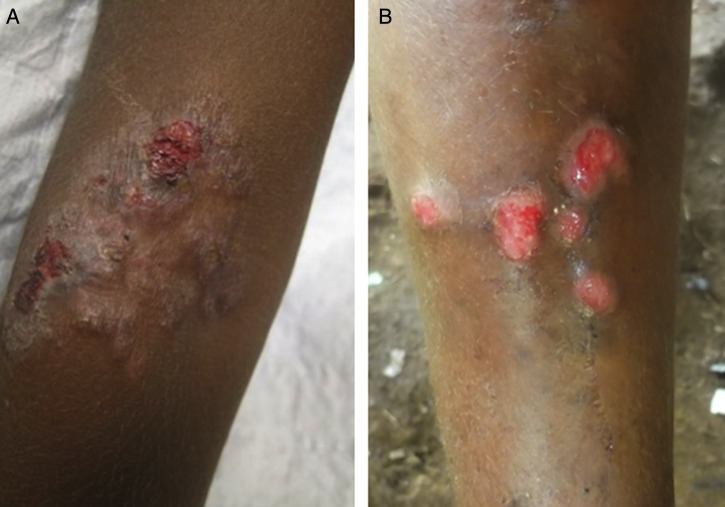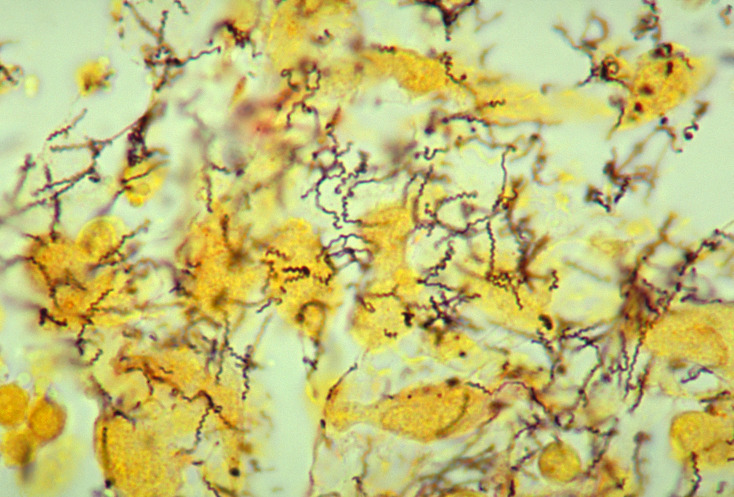Playlist
Show Playlist
Hide Playlist
Yaws, Pinta, and Bejel – The Endemic Treponematoses
00:01 Let's turn the tables now and go to the last diseases caused by Treponema. 00:06 Again, they get short shrift only because they're not common in most parts of the world and they're not as common today as they were certainly in the 1200-1300s. 00:16 The first of those is Yaws, and this is caused by Treponema pallidum pertenue. 00:22 It is a granulomatous disease and typically one will see lesions as you see in the picture here on the surface of the skin which are papilloma like so you might think wart like but even larger. 00:36 With variable skin, some which may look like granulomas in the skin. 00:40 Typically you’ll have nodules under the skin as well. 00:44 This disease if unrecognized and untreated, can go on to progress to destructive lesions underlying very much like the gummas that we talked about for Treponema pallidum, syphilis. 00:57 So one can have bony lesions, lymph tissue, connective tissue, etc. 01:02 Yaws, is most directly transmissible via direct contact with the lesions which will express a large number of active Treponema at their surface. 01:12 The treatment is penicillin just as it is with Treponema pallidum. 01:17 And then Pinta, the last of the three and this is caused by the Treponema carteneum and this is typically seen as a small pruritic papules as you can see on the image on the slide that those can progress both in a recurrent fashion or an ongoing fashion to cause raised, scarring or keloid formation in some and certainly later onset with depigmentation. 01:42 So one might see a patient walking around a country from Africa, for example, where one can still see Pinta, and see multiple pinpoint areas of hypopigmentation. 01:53 That would be a patient who may have suffered from Pinta. 01:56 Same transmission as with Yaws, same transmission as with syphilis - direct contact with lesions, any lesion with any form of Treponema is teeming with pathogens, so just say no, hands-off. 02:10 Treatment for Pinta is also with penicillin. Both Yaws and Pinta Another Treponema Pallidum infection is known as Beryl, which is caused by Treponema Pallidum endemic. 02:21 This disease is rare in the United States, but it is relatively common in certain parts of the world, including the Middle East and parts of Russia. 02:28 It is characterized by multiple mucosal ulcers, typically in the oropharynx and often starting in childhood. 02:34 If left untreated, it can progress and cause destructive and disfiguring lesions of the nose and palate similar to those seen in yaws. 02:42 Patients often complain of pain in their lower extremities during the secondary stage of this disease, as it inflames the periosteum of the long bones with a much more chronic inflammatory process. 02:53 Bowel can be transmitted via direct skin to skin contact or mouth to mouth contact, such as kissing or sharing drinks, straws, toothbrushes, etc.. 03:03 Treatment, as with other treponema infections, is with penicillin. 03:07 On the slide in front of you, the picture shows an oral lesion of primary bowel. 03:11 These diseases have a much slower progression without the severe additional manifestations we talked about in syphilis. 03:18 This is a long session talking about Treponema, I would like to say that these diseases are historic only but unfortunately, syphilis caused by Treponema pallidum is alive and well today and you’ll need to know all about it because I guarantee you’ll be seeing lots of patients with it.
About the Lecture
The lecture Yaws, Pinta, and Bejel – The Endemic Treponematoses by Sean Elliott, MD is from the course Bacteria.
Included Quiz Questions
Which type of skin lesions develop in yaws caused by Treponema pallidum?
- Elevated, papilloma-like skin lesions
- Elevated, ulcerated skin lesions
- Depressed, papilloma-like skin lesions
- Depressed, ulcerated skin lesions
- Elevated, nodular skin lesions
Which type of lesions initially develop in pinta caused by Treponema carateum?
- Small pruritic papules
- Large pruritic papules
- Small pruritic macules
- Small pruritic vesicles
- Large pruritic macules
Customer reviews
5,0 of 5 stars
| 5 Stars |
|
5 |
| 4 Stars |
|
0 |
| 3 Stars |
|
0 |
| 2 Stars |
|
0 |
| 1 Star |
|
0 |





